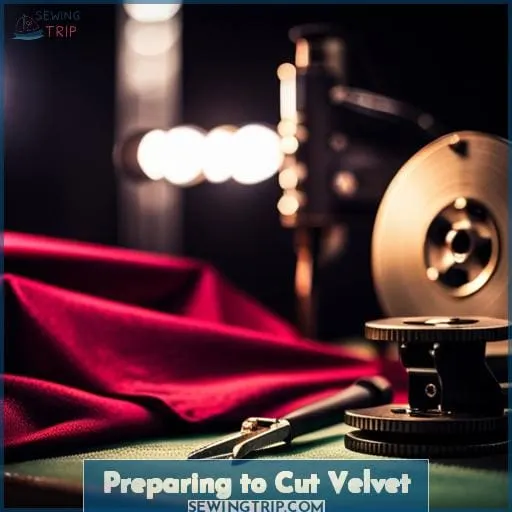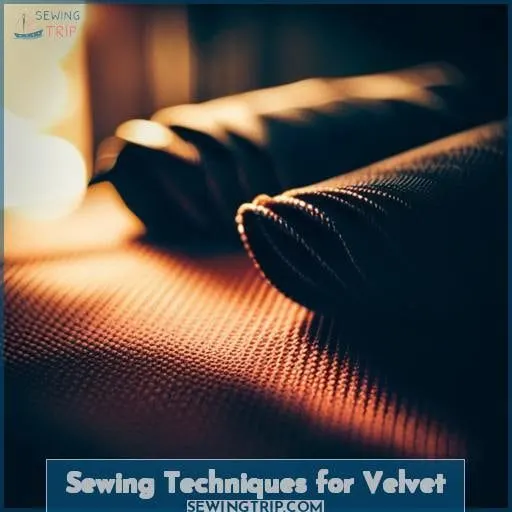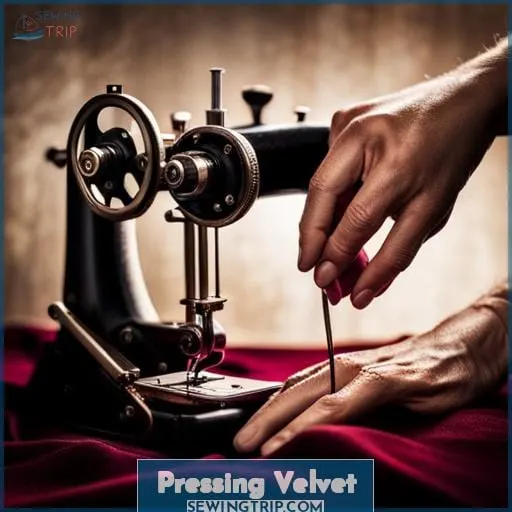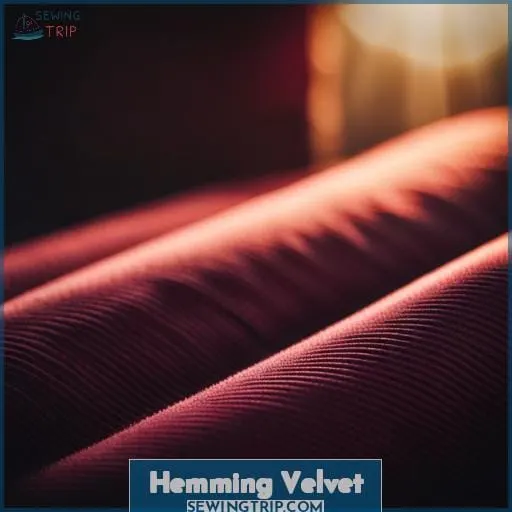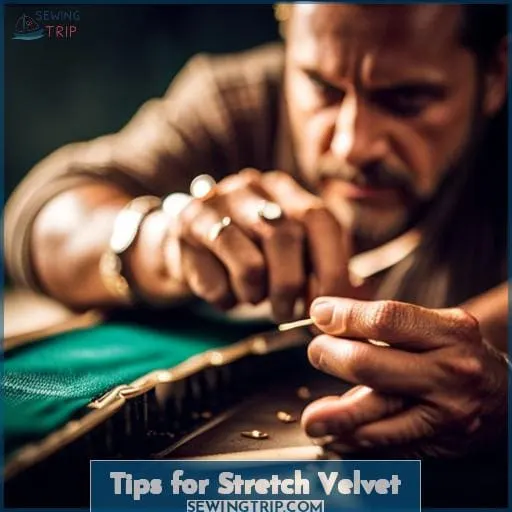This site is supported by our readers. We may earn a commission, at no cost to you, if you purchase through links.
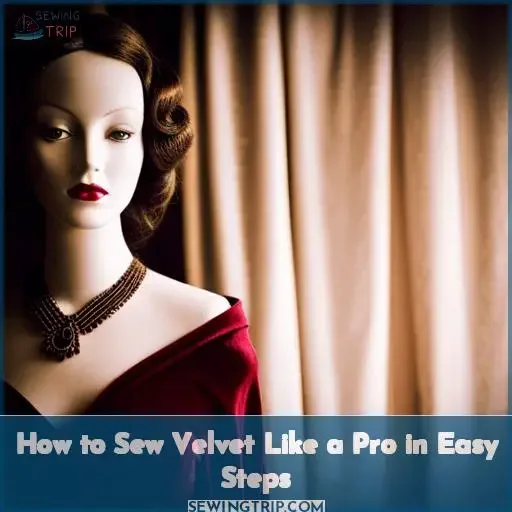 You crave the sensual silkiness of velvet.
You crave the sensual silkiness of velvet.
Yet its stubborn nature threatens your mastery.
Conquer velvet’s quirks.
Here’s how:
Follow nap direction.
Mark lines with tailor’s chalk.
Tame pile with tissue paper.
Avoid fusibles.
Sew seams open or serged.
Press lightly on the wrong side.
Hem by hand.
Test settings first.
Now you can reign over velvet and drape yourself in its richness.
Wield these 75 words of wisdom and make the velvet yours.
Table Of Contents
Key Takeaways
- Use a walking, Teflon, or roller foot when sewing velvet.
- Grade enclosed seams and trim close to the stitching for less bulk.
- Maintain nap direction consistency.
- Hand baste layers with silk thread for precision and stability.
Choosing a Velvet Pattern
When sewing with velvet fabric, your pattern choice is key.
Consider style lines, seam placement, and closures to find a design suited to velvet’s delicate nature.
Simple designs with minimal shaping will be the most beginner-friendly.
Velvet Fabric Considerations
For fine velvets, choose a pattern with simple lines, minimal design details, and semi-fitted to loose silhouettes.
Consider the color palette, texture variations, fiber content, and seasonal adaptations when selecting a velvet.
Pair with complementary fabrics and add embellishments for interest.
Special Sewing Techniques
You’ll need to use specialty techniques like:
- Testing stitch settings on scraps.
- Hand-basting layers.
- Using walking, Teflon, or roller foot.
- Gently steam pressing only the wrong side.
Flat Pattern Adjustments
A few key pattern adjustments before cutting help ensure your velvet garment fits smoothly and hangs properly.
Prioritize fit tweaks like:
- Bust darts
- Waist shaping
- Sleeve cap ease
- Length changes
These adjustments enhance the garment silhouette.
Consider style modifications like:
- Converting closures
- Adjusting seam allowances
These modifications create a refined velvet finish.
Preparing to Cut Velvet
Before cutting your velvet, ensure you have tissue paper on hand to place between the fabric layers.
This prevents the pile from becoming compressed and maintains the integrity of the nap direction.
Be mindful of layout to keep the nap running in the intended direction across all pattern pieces.
Tissue Paper
When cutting single-layer velvet, use tissue paper underneath to prevent shifting and allow easier movement.
The tissue stabilizes the pile and slippery surface, enabling precise cutting along marked lines.
Choose lightweight, thin paper that won’t distort the fabric’s drape or add bulk when sewing seams.
Tissue paper facilitates effortless repositioning, essential for maintaining proper grainlines and nap direction.
With this velvet cutting trick, you’ll achieve flawless precision critical for quality results.
Nap Direction
Your consistency in following the fabric’s nap direction across all pattern pieces enhances the finished garment’s appearance.
When laying out velvet, mind the fabric’s nap direction for optimal highlights.
Position all pattern pieces facing the same direction to maintain consistency throughout the sewing process.
Mastering nap alignment early on elevates your velvet garments.
Marking and Interfacing Velvet
Trace your pattern markings onto the wrong side of the velvet using disappearing ink to avoid damaging the delicate pile.
When marking velvet, prioritize gentler techniques like tailor’s tacks, thread tracing, snip notches, or chalk over tracing wheels to minimize harm.
Consider lightweight interfacing on collar and hem allowances, strategically fused to only one layer of the double cloth velvet.
For precision marking and fabric stability when sewing, first hand baste with silk thread. This secures the double cloth layers in place during construction without shifting.
When sewing velvet, adjusting machine tension prevents skipped stitches; maintain taut fabric layers with vertical pins.
Thoughtful preparation preserves the enchanting drape and plush texture of velvet.
Preventing Velvet Creeping
Hand basting prevents your velvet’s tendency to creep before sewing.
Ensure the velvet nap runs in the same direction across all pattern pieces. This consistency in nap direction enhances the garment’s cohesion.
Vertical pinning with sharps pointing toward the machine also helps align layers.
For precision alignment without shifting, use wonder tape or temporary spray adhesive cautiously within seam allowances.
Hand-basting with silk thread offers adjustability without permanent adhesion.
Proper stabilization is key; lining velvet garments boosts structure and prevents creeping.
Allow projects to hang before hemming to relax the fabric.
Blind hem stitches or clean serged edges deliver hem finishes without topstitching or added bulk.
With care in preparation and stabilization, your velvet layers need not creep.
Sewing Techniques for Velvet
When sewing velvet, begin by testing stitches on scraps to find the best needle size, tension, and stitch length for the fabric.
Use universal or sharp machine needles in sizes 70/10 or 80/12 and experiment with polyester or cotton threads.
Adjust the upper tension and use a longer stitch length of 3-4mm to allow the threads to embed into the pile properly.
Lower the presser foot pressure if possible to prevent crushing the nap during stitching.
Consider fabric handling aids like a walking foot, Teflon foot, or roller foot to ensure smooth feeding under the presser foot.
Hand-basting sections first can also help prevent creeping and shifting while stitching.
Grade enclosed seams and trim close to the stitching line for the least bulk.
For an elegant finish, try lining velvet garments and binding edges with straight grain or bias strips of lining fabric.
Steam pressing and plenty of testing on scraps is key for sewing success with velvet.
Pressing Velvet
You’ll want to press velvet delicately, using steam while avoiding direct contact between the iron and the fabric’s pile.
When pressing velvet, protect the fabric’s right side by placing a scrap piece wrong side up atop the garment section being pressed.
Apply steam through this protective barrier to shape velvet without crushing the nap.
Allow sections to fully dry before moving or handling to retain the pressed shape.
Consider using specialty needle boards or press cloths designed for velvet’s unique requirements.
Proper steaming technique prevents pile damage while lending refined shaping.
With care, pressing enhances velvet’s luxurious drape and liberates its striking, light-reflecting texture coveted since antiquity across societies.
Mastering professional pressing elevates velvet to new heights.
Hemming Velvet
You’d then hang the velvet garment for 24 hours before hemming to allow the fabric to relax.
Hemming velvet poses unique challenges due to the delicate pile and tendency to shift.
When handling velvet, exercise care to avoid catching the fabric on pins or needles.
Consider serging the raw edge first to minimize fraying.
For straight hems, a single-fold finish caught with an invisible stitch creates the least bulk.
For fullness, use double-fold hems, grading the seam allowances.
Steam press completed hems, using a press cloth to protect the fabric.
Finger press folds gently.
Proper hem finishing maintains the beauty of velvet while allowing the garment to hang and wear perfectly.
Tips for Stretch Velvet
Although stretch velvet requires some special considerations, you’ll want to use ballpoint needles and adjust your serger’s differential feed when sewing it.
- Use ballpoint needles in your sewing machine for stitching stretch velvet. This prevents skipped stitches.
- Test different stitch lengths and tension settings on velvet scraps first. Longer stitches around 3 mm work well.
- Consider a zigzag or stretch stitch to accommodate the fabric’s stretch.
- When serging, adjust the differential feed to match the amount of stretch in the velvet.
- Allow the cut garment pieces to hang 24 hours before hemming. This allows the fabric to relax into its natural drape.
- Opt for a twin needle when hemming stretch velvet to add flexibility and prevent popping stitches.
- Hand-baste hems first to prevent creeping and shifting while stitching.
- Interface hem allowances with lightweight knit interfacing for added structure.
- Carefully clip and notch curved seams to maintain stretch capacity.
Testing Settings on Velvet
After discussing tips for sewing stretch velvet, it’s time to ensure your machine settings and thread are dialed in before cutting into your velvet yardage.
Set aside some fabric scraps and do preliminary testing to determine the ideal needle size, stitch length, and thread for your project.
Adjusting your machine to a sharp needle like a 70/10 or 80/12 along with a slightly loosened tension and longer stitch length often yields the best results.
Test different thread weights as well, using finer threads like 100% cotton or silk for basting and a smooth polyester thread in the top and bobbin for final seams.
Once your stitching looks smooth without skipping or puckering on the fabric scraps, note down your optimized settings before moving on to cutting and sewing the actual garment.
Proper testing helps achieve a refined finish when sewing delicacies like velvet.
Frequently Asked Questions (FAQs)
What kind of thread should I use when sewing velvet?
Use fine 100% cotton or silk thread when stitching velvet.
Aim for minimum bulk and disturbance of the pile surface.
Variable thread weights can complement the velvet’s delicacy or sturdiness.
Test on scraps first.
How do I clean velvet garments?
With consideration, clean velvets gently.
Vacuum or freshen on the reverse using steam.
Never immerse pile fabrics in water, but spot treat stains as needed.
Protect the surface while drying flat away from direct heat.
What alterations are recommended for velvet garments?
When altering velvet, prioritize simple adjustments like hems.
Avoid complicated pattern changes to preserve the fabric’s drape and minimize bulk.
Make muslin prototypes first.
Steaming allows slight shaping without crushing the pile.
What grain should velvet be cut on?
Cut velvet on the lengthwise grain for the most pleasing drape.
This places the pile in the same direction and allows the fabric’s natural stretch across the grain.
Handle velvet with care when laying out, pinning, and cutting to prevent distortion.
How do I store unfinished velvet projects?
To avoid crushing the velvet’s pile, store unfinished projects face up on smooth surfaces padded with tissue paper.
Keep pieces flat; weigh edges down gently if needed.
Conclusion
Conquer the velvet and claim it as your own.
Let its luxurious texture caress you as you dazzle in its richness.
Armed with tissue paper and tailor’s chalk,
Mark victory lines across its plush terrain.
Along seams serged, applaud your mastery with gentle press.
Hand-stitch each hem for an unrivaled finish.
Now drape yourself in velvet’s sensuality,
A cloak of flawless technique and patience mastered.
Velvet yearns to be tamed – heed wisdom’s call and reign supreme.


